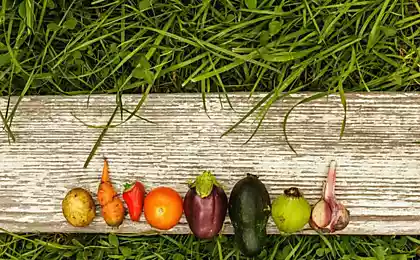469
Live Kashi without cooking
When I lived in a city apartment and thought about life on the estate, looking for an alternative to urban benefits, I called for the question on how to cook plain porridge (buckwheat, wheat, oat, barley, etc.), while not using fire or electricity, that is, to do without cooking?

Immediately I remembered how my aunt had filled with water and beans and left it like that overnight in the morning boil the soup quickly (over night beans were swollen due to which it do not need long to cook). I had the idea to do the same with cereals. What was my surprise, when soaked in this way the buckwheat was absolutely ready to eat, did not want her to cook!
I must say that the taste I don't quite like (I usually added to the porridge, salt and butter), but there was a reason – a habit. Later going on a raw food diet and giving up salt and sugar, I appreciated the superiority of cereals, as was the bright taste of each product. Also eating buckwheat porridge with salt and butter, we taste the latter, but not the buckwheat.
After experimenting with steeping various herbs, I made a time table, the minimum required for cooking specific cereals (minimum time of soaking in cold water:
Want to expand a little on the wrist. The buckwheat, which You buy in the store (brown color) is FRIED! Ordinary buckwheat seeds and remove the outer (black) shell mechanical method, and then purified buckwheat has a greenish color and the taste has nothing to do with the store. Now imagine – You buy roasted buckwheat, then cook it (and, most likely, more than once, because the time still warm), You use double-killed buckwheat!
Soaked grains are alive (they can grow), they will give You all the nutrients without loss, and welded to boast of it can't – heat treatment kills them and reduces the content of useful substances.
The above sign is correct only when the air temperature is not below +1°C, because under natural winter conditions at the time of soaking water simply freezes – this is another reason for thinking about food is in the estate, do I need to eat cereal in the winter... But that's another story.
Select your cereal!
BUCKWHEAT: rich in iron and calcium, b vitamins, contains a lot of easily digestible proteins (and therefore in China it is considered a substitute to meat). Useful for the prevention of cardiovascular disease, helps with hypertension, liver disease, edema. Normalizes digestion and bowel function. In addition, buckwheat contains 8% of quercetin, which is considered one of the most powerful natural substances for the prevention and therapy of cancer.
Calories: 329 kcal/100 gr.
CORN: promotes healing of the intestine, contains silicon, which has a positive effect on dental health. Another plus is that the corn turns out low-calorie porridge, which is also capable of outputting the fat from the body.
Calorie content: 325 kcal/100 g.
SEMOLINA: contrary to the stereotype, not the most helpful of porridge. First, it contains very allergenic vegetable protein gluten, secondly, leaches the body of calcium. On the other hand, it is recommended to all who suffer from diseases of the stomach.
Calories: 326 kcal/100g.
OATS: are high in calories, gives "wraparound" effect. Useful in diseases of the gastrointestinal tract (gastritis, stomach ulcer, etc.)
Calories: 345 kcal/100 g.
BARLEY: normalizes metabolism (for example, in the initial stages of obesity), rich in trace elements, vitamins of group B. it also helps with allergies, it is recommended for the prevention of anemia.
Calories: 324 kcal/100 g.
MILLET: displays the body of excess mineral salts, binds and removes from the body fats. Millet is rich in vitamin a, which helps to retain moisture in the skin and promotes its regeneration. In addition, the cereal contains calcium and magnesium, which are necessary for normal functioning of the heart and blood vessels. Bad one – the millet is stored briefly (a measure of freshness – full yellow). If the dealer paled, then lost the vast majority of its beneficial properties.
Calories: 334 kcal/100 gr.
RICE: the low-calorie cereal. Contains a lot of vegetable proteins and starch, easy to digest.
Calories: 323 kcal/100g.published
P. S. And remember, only by changing their consumption — together we change the world! ©
Source: www.ecology.md

Immediately I remembered how my aunt had filled with water and beans and left it like that overnight in the morning boil the soup quickly (over night beans were swollen due to which it do not need long to cook). I had the idea to do the same with cereals. What was my surprise, when soaked in this way the buckwheat was absolutely ready to eat, did not want her to cook!
I must say that the taste I don't quite like (I usually added to the porridge, salt and butter), but there was a reason – a habit. Later going on a raw food diet and giving up salt and sugar, I appreciated the superiority of cereals, as was the bright taste of each product. Also eating buckwheat porridge with salt and butter, we taste the latter, but not the buckwheat.
After experimenting with steeping various herbs, I made a time table, the minimum required for cooking specific cereals (minimum time of soaking in cold water:
- Buckwheat — 1 hour
- Wheat — 30 hours
- Rye — 12 hours
- Oats — 4 hours
- Barley — 2 hours
- Fig — 70 hours
- Rye, oats, wheat flakes — 5-10 minutes
Want to expand a little on the wrist. The buckwheat, which You buy in the store (brown color) is FRIED! Ordinary buckwheat seeds and remove the outer (black) shell mechanical method, and then purified buckwheat has a greenish color and the taste has nothing to do with the store. Now imagine – You buy roasted buckwheat, then cook it (and, most likely, more than once, because the time still warm), You use double-killed buckwheat!
Soaked grains are alive (they can grow), they will give You all the nutrients without loss, and welded to boast of it can't – heat treatment kills them and reduces the content of useful substances.
The above sign is correct only when the air temperature is not below +1°C, because under natural winter conditions at the time of soaking water simply freezes – this is another reason for thinking about food is in the estate, do I need to eat cereal in the winter... But that's another story.
Select your cereal!
BUCKWHEAT: rich in iron and calcium, b vitamins, contains a lot of easily digestible proteins (and therefore in China it is considered a substitute to meat). Useful for the prevention of cardiovascular disease, helps with hypertension, liver disease, edema. Normalizes digestion and bowel function. In addition, buckwheat contains 8% of quercetin, which is considered one of the most powerful natural substances for the prevention and therapy of cancer.
Calories: 329 kcal/100 gr.
CORN: promotes healing of the intestine, contains silicon, which has a positive effect on dental health. Another plus is that the corn turns out low-calorie porridge, which is also capable of outputting the fat from the body.
Calorie content: 325 kcal/100 g.
SEMOLINA: contrary to the stereotype, not the most helpful of porridge. First, it contains very allergenic vegetable protein gluten, secondly, leaches the body of calcium. On the other hand, it is recommended to all who suffer from diseases of the stomach.
Calories: 326 kcal/100g.
OATS: are high in calories, gives "wraparound" effect. Useful in diseases of the gastrointestinal tract (gastritis, stomach ulcer, etc.)
Calories: 345 kcal/100 g.
BARLEY: normalizes metabolism (for example, in the initial stages of obesity), rich in trace elements, vitamins of group B. it also helps with allergies, it is recommended for the prevention of anemia.
Calories: 324 kcal/100 g.
MILLET: displays the body of excess mineral salts, binds and removes from the body fats. Millet is rich in vitamin a, which helps to retain moisture in the skin and promotes its regeneration. In addition, the cereal contains calcium and magnesium, which are necessary for normal functioning of the heart and blood vessels. Bad one – the millet is stored briefly (a measure of freshness – full yellow). If the dealer paled, then lost the vast majority of its beneficial properties.
Calories: 334 kcal/100 gr.
RICE: the low-calorie cereal. Contains a lot of vegetable proteins and starch, easy to digest.
Calories: 323 kcal/100g.published
P. S. And remember, only by changing their consumption — together we change the world! ©
Source: www.ecology.md























